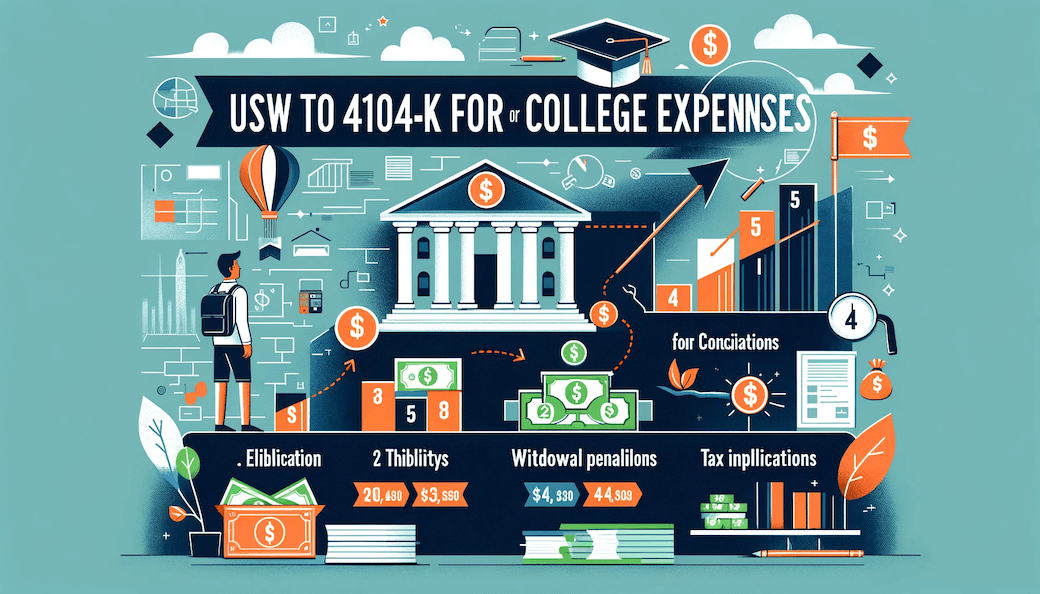
In an era of escalating college costs, students and families are increasingly exploring unconventional funding sources. Traditionally viewed as a retirement tool, the 401(k) plan is now being considered for educational funding. This shift raises important questions about the feasibility and wisdom of using retirement savings to invest in education. This comprehensive guide delves into the intricacies of utilizing 401(k) savings for college expenses, weighing the pros and cons, and offering strategic insights for those considering this option.
Understanding 401(k) Plans
The 401(k) plan, named after the U.S. Internal Revenue Code section that governs it, is a popular employer-sponsored retirement savings vehicle. Employees contribute a portion of their salary, often matched by their employer, into a tax-advantaged account. These contributions are typically made pre-tax, reducing taxable income and allowing the investment to grow tax-deferred. Withdrawals made after age 59½ are taxed as regular income.
Two main types of 401(k) plans exist: traditional and Roth. The traditional 401(k) offers immediate tax benefits, as contributions lower taxable income. Conversely, Roth 401(k) contributions are made with after-tax dollars, and withdrawals during retirement are generally tax-free.
Understanding contribution limits is crucial. For 2023, individuals can contribute up to $20,500, with a $6,500 catch-up contribution for those over 50. These contributions, combined with potential employer matching and compound interest, make 401(k)s a powerful retirement saving tool.
Can 401(k) Be Used for College?

Yes, funds from a 401(k) retirement savings plan can be used for college expenses, but several important factors must be considered before doing so. Here’s a detailed look at how 401(k) plans can be utilized for education expenses:
Legal Framework and Rules
- Early Withdrawal: Typically, funds withdrawn from a 401(k) before the age of 59½ are subject to a 10% early withdrawal penalty and taxed as ordinary income. However, if you leave your job during or after the year you turn 55, you might be able to withdraw without the 10% penalty.
- Hardship Withdrawals: Some 401(k) plans allow for hardship withdrawals, which can include expenses for higher education. However, these withdrawals are subject to taxes and potentially the 10% penalty.
- Loan Option: Many 401(k) plans offer the option to take out a loan against your account balance. This loan must be repaid with interest, usually through payroll deductions. The advantage of a loan is that it’s not subject to taxes or early withdrawal penalties as long as it’s repaid according to the plan’s terms.
Tax Implications
- Income Taxes: Withdrawals from a traditional 401(k) are taxed as ordinary income. This means the amount you withdraw will be added to your taxable income for the year, which could push you into a higher tax bracket.
- Effect on Financial Aid: Withdrawals count as income on financial aid applications (FAFSA), potentially reducing eligibility for need-based aid in subsequent years.
Strategic Considerations
- Impact on Retirement Savings: Using 401(k) funds for college can significantly reduce your retirement savings. The long-term effect of this reduction, compounded by the loss of future earnings on those funds, can be substantial.
- Alternatives: Before using a 401(k) for college, consider other options like 529 plans, scholarships, grants, student loans, and work-study programs. These alternatives often have more favourable terms for educational expenses.
- Family Impact: The decision to use retirement funds for education also affects family financial planning. It’s important to balance the needs of college funding with the long-term goal of retirement security.
While it’s legally possible to use a 401(k) for college expenses, it comes with significant financial considerations, including taxes, penalties, and the impact on retirement savings. Before making this decision, evaluating all available options and potentially consulting with a financial advisor is crucial. The goal should be to balance supporting educational goals and maintaining financial stability in the future.
Pros of Using 401(k) for College
Using a 401(k) to fund college expenses is a decision that requires careful consideration of its benefits and drawbacks. This comprehensive analysis will delve into the pros and cons of this approach, offering insights to help you make an informed decision.
1. Immediate Access to Funds
One of the primary advantages of using a 401(k) for college is the immediate access to funds. Unlike some college savings plans that may have age or usage restrictions, 401(k) funds are readily available when you decide to withdraw them.
2. Potential for Higher Returns
The investment options in a 401(k) plan often include a variety of stocks, bonds, and mutual funds, which could offer higher returns compared to traditional college savings plans.
3. No Contribution Limits for Educational Expenses
Unlike specific education savings accounts with annual contribution limits, a 401(k) allows for more substantial contributions, potentially leading to a larger fund for college expenses.
4. Tax Benefits
Contributions to a traditional 401(k) are made pre-tax, which reduces your taxable income in the contribution year. This can be a significant tax advantage, especially for those in higher tax brackets.
Cons of Using 401(k) for College
Penalties and Taxes on Early Withdrawals
Withdrawing from your 401(k) before the age of 59½ typically incurs a 10% early withdrawal penalty plus income taxes on the amount withdrawn. This can significantly reduce the amount available for college expenses.
1. Impact on Retirement Savings
Using 401(k) funds for college can substantially diminish your retirement nest egg. This is particularly concerning given the compounding nature of retirement savings, where the long-term impact of early withdrawals can be substantial.
2. Effect on Financial Aid Eligibility
Withdrawals from a 401(k) are considered income in the year they are taken. This increased income can affect a student’s eligibility for need-based financial aid, potentially reducing the assistance received.
3. Opportunity Cost
The money withdrawn for college expenses loses the potential growth it could have earned if left invested for retirement. This opportunity cost can be significant, especially over a long investment horizon.
4. Limited Investment Options
While 401(k) plans offer various investment choices, they are generally more limited than other investment vehicles. This restriction can impact the growth potential of funds intended for college expenses.
5. Risk of Market Fluctuations
The value of investments in a 401(k) can be volatile, depending on market conditions. Withdrawing funds during a market downturn can mean locking in losses and having less money available for college costs.
Deciding whether to use a 401(k) for college funding involves a complex evaluation of both immediate financial needs and long-term financial health. While it offers an accessible source of funds with potential tax benefits, the downsides, particularly the impact on retirement savings and eligibility for financial assistance, are significant. It’s crucial to weigh these factors against other available options for college funding and consult with a financial advisor to understand the implications fully. Making an informed decision is key to balancing educational aspirations with long-term financial security.
Strategies for Using 401(k) for College

Utilizing a 401(k) to fund college expenses requires strategic planning to minimize financial drawbacks. Here are several strategies to consider if you’re contemplating using your 401(k) savings for education:
1. Assessing the Need
- Calculate the Required Amount: Determine how much money you need from your 401(k) to cover college expenses. This helps in understanding the impact of the withdrawal on your retirement savings.
- Explore All Funding Options: Before tapping into your 401(k), explore all other funding sources, including scholarships, grants, student loans, and education-specific savings plans like 529 plans.
2. Choosing Between Loan and Withdrawal
401(k) Loans
- Borrowing Limits: Typically, you can borrow up to 50% of your vested account balance or a maximum of $50,000, whichever is less.
- Repayment Terms: Loans must be repaid within five years, with interest paid back into your 401(k).
- Pros: Loans are not subject to taxes or early withdrawal penalties. Also, you’re paying the interest back to your account.
- Cons: If you leave your job, the loan might need to be repaid in full immediately. It’s treated as a distribution and subject to taxes and penalties if you can’t repay it.
3. Direct Withdrawals
- Tax Implications: Withdrawals are subject to income tax and, if under age 59½, a 10% early withdrawal penalty.
- Impact on Retirement Savings: Withdrawals permanently reduce your retirement savings and its potential growth.
4. Managing the Impact on Retirement
- Increase Future Contributions: If you take a loan or make a withdrawal, plan to increase your future 401(k) contributions to replenish your retirement savings.
- Delay Retirement: Consider delaying retirement to give your savings more time to grow and compensate for the withdrawn amount.
- Diversify Investments: After the withdrawal or loan, reassess your investment strategy to ensure it aligns with your revised retirement goals and timeline.
5. Consulting with Professionals
- Financial Advisor: A financial advisor can help you understand the long-term implications of using your 401(k) for college and assist in developing a comprehensive financial plan.
- Tax Professional: Consult a tax advisor to understand the tax implications of a 401(k) loan or withdrawal and how it affects your overall tax situation.
Using a 401(k) for college expenses can be viable under certain circumstances, but it requires careful consideration and strategic planning. Weigh the immediate benefits of accessing these funds against the long-term impact on your retirement. Consider alternative funding sources first and seek professional advice to make an informed decision that aligns with your educational and retirement objectives.
Final Thoughts
In navigating the complexities of funding college education, especially when considering using 401(k) plans, it is essential to have a comprehensive understanding of your savings and investment options. The Dave Ramsey College Savings Calculator emerges as a valuable tool. While our guide has explored the intricate details of utilizing 401(k) savings for college expenses, this calculator provides a practical approach to estimating and planning college savings. Considering various financial scenarios and timelines helps discern how much needs to be saved. Utilizing this tool with the insights provided in this guide can empower students and families to make informed decisions about college funding, balancing educational aspirations with long-term financial health and stability.



